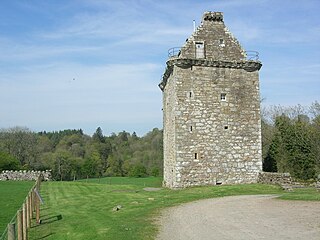
James V was King of Scotland from 9 September 1513 until his death in 1542. He was crowned on 21 September 1513 at the age of seventeen months. James was the son of King James IV and Margaret Tudor, and during his childhood Scotland was governed by regents, firstly by his mother until she remarried, and then by his second cousin, John, Duke of Albany. James's personal rule began in 1528 when he finally escaped the custody of his stepfather, Archibald Douglas, Earl of Angus. His first action was to exile Angus and confiscate the lands of the Douglases.

Border reivers were raiders along the Anglo-Scottish border from the late 13th century to the beginning of the 17th century. They included both Scottish and English people, and they raided the entire border country without regard to their victims' nationality. Their heyday was in the last hundred years of their existence, during the time of the House of Stuart in the Kingdom of Scotland and the House of Tudor in the Kingdom of England.

Hermitage Castle is a semi-ruined castle in the border region of Scotland. It is under the care of Historic Scotland. The castle has a reputation, both from its history and its appearance, as one of the most sinister and atmospheric castles in Scotland.
Sir Thomas Wharton, 1st Baron Wharton was an English nobleman and a follower of King Henry VIII of England. He is best known for his victory at Solway Moss on 24 November 1542 for which he was given a barony.
William Armstrong of Kinmont or Kinmont Willie was a Scottish border reiver and outlaw active in the Anglo-Scottish Border country in the last decades of the 16th century.

Walter Scott, 5th of Buccleuch, 1st Lord Scott of Buccleuch was a Scottish nobleman and famous border reiver, known as the "Bold Buccleuch" and leader of Kinmont Willie's Raid. Scott was the son of Sir Walter Scott, 4th of Buccleuch and Margaret Douglas.

Clan Armstrong is a Scottish clan of the Scottish Borders.

Liddesdale, the valley of the Liddel Water, in the County of Roxburgh, southern Scotland, extends in a south-westerly direction from the vicinity of Peel Fell to the River Esk, a distance of 21 miles (34 km). The Waverley route of the North British Railway runs down the dale, and the Catrail, or Picts' Dyke, crosses its head.
Willie O Winsbury is Child Ballad 100. The song, of which there are many variants, is a traditional Scottish ballad that dates from at least 1775, and is known under several other names, including "Johnnie Barbour" and "Lord Thomas of Winesberry".

The Debatable Lands, also known as debatable ground, batable ground or threip lands, lay between Scotland and England. It was formerly in question as to which it belonged when they were distinct kingdoms. The name either signifies litigious or disputable ground, or it comes from the Old English word 'battable'.
"Hughie Graham" or "Hughie Graeme" is Child ballad number 191, Roud 84, existing in several variants. It was collected by Robert Burns. There is a printed version in the Bodleian Library under the title "The Life and Death of Sir Hugh The Grime". It is dated between 1672 and 1696. The Burns version was printed by James Johnson (engraver) in the Scots Musical Museum 1803. It is in volume 4 song no 303, pages 312 and 313. The Vaughan Williams Memorial Library lists several other versions in printed collections, including "Scottish Ballads" (1829) by Robert Chambers.
Johnie Cock is a traditional Scottish folk ballad, listed as the 114th Child Ballad and number 69 in the Roud Folk Song Index.
Canonbie is a small village in Dumfriesshire within the local authority area of Dumfries and Galloway in Scotland, 6 miles south of Langholm and 2 miles north of the Anglo-Scottish border. It is on the A7 road from Carlisle to Edinburgh, and the River Esk flows through it. There are frequent references in older documents to it as Canobie.

The Anglo-Scottish border is a border separating Scotland and England which runs for 96 miles (154 km) between Marshall Meadows Bay on the east coast and the Solway Firth in the west.

Sir Walter Scott, 1st of Branxholme, 3rd of Buccleuch, known as "Wicked Wat", was a nobleman of the Scottish Borders and the chief of Clan Scott who briefly served as Warden of the Middle March He was an "inveterate English hater" active in the wars known as The Rough Wooing and a noted Border reiver. He was killed on Edinburgh High Street in a feud with Clan Kerr in 1552. His great-grandson was Sir Walter Scott, 1st Lord Scott of Buccleuch, the "Bold Buccleuch" (1565–1611), a border reiver famed for his role in the rescue of Kinmont Willie Armstrong.
William Armstrong (1565-1649), known as Christie's Will, was a Scottish Borders freebooter of the 17th century, celebrated in a ballad by Sir Walter Scott.

Clan Little is a Scottish clan of the Borders. The clan does not currently have a chief and is therefore considered an armigerous clan. The Clan Little Society had a Guardian in place of a clan chief but, since his death in 2007, no suitable successor has appeared.

The Battle of Dryfe Sands was a Scottish clan battle that took place on 6 December 1593, near Lockerbie, Scotland. It was fought between the Clan Maxwell and Clan Johnstone after a hundred years of feuding between them. The Johnstones won a decisive victory over the Maxwells.

Mangerton Tower is a ruined Scottish tower castle house formerly belonging to the Armstrong family.













